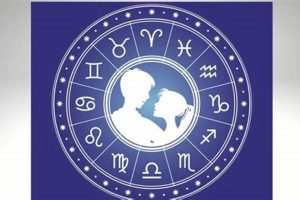Individuals born in October fall under either the Libra (September 23 – October 22) or Scorpio (October 23 – November 21) zodiac signs, according to Western astrology. Those born under Libra are often associated with balance, harmony, and diplomacy. Scorpio-born individuals are often characterized by their intensity, passion, and resourcefulness. The New York Times (NYT), like many other publications, may publish articles relating to horoscopes, personality traits associated with these signs, or broader astrological trends.
Astrology, while not scientifically validated, holds cultural significance for many. Articles about astrological signs can provide entertainment, self-reflection, or a sense of community for those interested in exploring these belief systems. The NYT’s coverage might explore the historical context of these signs, analyze their cultural impact, or provide lifestyle advice tailored to each sign’s purported characteristics. Such articles can offer a lens for understanding personality traits and potential life paths, albeit through a non-scientific framework.
Further exploration of these signs can encompass examining their elemental associations (air for Libra, water for Scorpio), ruling planets (Venus for Libra, traditionally Mars and now also Pluto for Scorpio), and their corresponding modalities (cardinal for Libra, fixed for Scorpio). These astrological components contribute to the nuanced interpretations attributed to individuals born under these signs. Exploring these astrological aspects can offer a deeper understanding of their supposed influences.
Tips for October-Born Individuals
The following offers guidance based on common characteristics associated with the two astrological signs observed in October.
Tip 1: Embrace Balance (Libra): Seek equilibrium in various life aspects, from work-life balance to interpersonal relationships. This might involve setting clear boundaries, prioritizing self-care, and practicing mindful decision-making.
Tip 2: Channel Intensity (Scorpio): Harness inherent passion and drive toward productive pursuits. This could involve focusing on a specific project, engaging in deep research, or pursuing creative endeavors.
Tip 3: Cultivate Diplomacy (Libra): Practice active listening and strive for compromise in disagreements. This can foster stronger relationships and create more harmonious environments.
Tip 4: Embrace Transformation (Scorpio): Recognize the power of personal growth and embrace change as an opportunity for evolution. This might involve exploring new interests, challenging existing beliefs, or stepping outside comfort zones.
Tip 5: Express Creativity (Libra): Explore artistic outlets to express innate sense of aesthetics and beauty. This could involve engaging in visual arts, music, writing, or other creative pursuits.
Tip 6: Develop Intuition (Scorpio): Pay attention to gut feelings and inner wisdom when navigating challenges. This can lead to more informed decisions and greater self-awareness.
Tip 7: Seek Connection (Libra): Nurture relationships and build community through shared interests and open communication. This can create a sense of belonging and enhance overall well-being.
By understanding and applying these suggestions tailored to the characteristics generally attributed to October’s astrological signs, individuals born during this month can potentially enhance their personal and interpersonal development.
This exploration of astrological influences serves as a starting point for self-reflection and growth. Further exploration of these concepts can provide deeper insights into individual strengths and potential areas for development.
1. Astrology
Astrology, a belief system linking celestial positions to human affairs and terrestrial events, forms the foundation for understanding “astrological sign of October NYT.” This framework provides the context for interpreting the perceived influence of planetary alignments on individuals born during October, as potentially discussed in New York Times articles.
- Zodiac Signs:
The zodiac, a band of twelve constellations along the ecliptic, forms the basis of astrological signs. Each sign occupies a 30-degree segment, and an individual’s sun sign is determined by the sun’s position within the zodiac at their birth. For October, this encompasses Libra and Scorpio. Articles referencing “astrological sign of October NYT” likely focus on these two signs and their associated characteristics.
- Planetary Influences:
Astrology posits that planets exert distinct influences on individuals, depending on their positions at the time of birth. These influences are interpreted within the framework of the zodiac signs and their assigned characteristics. Discussions of Libra and Scorpio within the context of “astrological sign of October NYT” may include analysis of their ruling planets (Venus for Libra, Mars and Pluto for Scorpio) and their perceived effects.
- Horoscopes:
Horoscopes are astrological charts depicting planetary positions at a specific moment in time, often used to predict or interpret events. Articles referencing “astrological sign of October NYT” could include horoscopes tailored to Libra and Scorpio, offering forecasts or insights based on planetary transits.
- Cultural Interpretation:
Astrology has a rich cultural history and continues to influence popular culture. The “astrological sign of October NYT” phrase highlights this intersection, recognizing that astrological concepts appear in mainstream media outlets like the New York Times. This demonstrates astrology’s ongoing relevance in shaping societal beliefs and interpretations of personality and fate.
These facets of astrology provide a framework for interpreting the “astrological sign of October NYT” concept. By understanding zodiac signs, planetary influences, horoscopes, and the cultural context of astrology, one can better analyze discussions and interpretations offered in media coverage relating to individuals born in October.
2. October
October’s significance within the phrase “astrological sign of October NYT” stems from its association with two specific zodiac signs: Libra and Scorpio. This temporal placement determines which astrological influences are attributed to individuals born during this month. The relationship is causal: October’s position within the solar year dictates the sun’s transit through specific zodiac constellations, thereby assigning Libra or Scorpio as the corresponding sun sign. Without October’s placement within the yearly cycle, the astrological attributions would differ. For example, an individual born on October 15th falls under Libra, while someone born on October 28th is categorized as a Scorpio. These distinct classifications, determined by the birthdate falling within October, lead to different astrological interpretations, influencing personality profiles, predictions, and advice offered within publications like the New York Times.
Understanding this connection allows for more accurate interpretation of astrological information. Readers seeking horoscope readings or personality analyses in the New York Times, or any publication referencing “October,” must consider the specific date within the month to determine the correct zodiac sign and its associated characteristics. For example, a generalized October horoscope without specifying Libra or Scorpio might offer contradictory information, confusing readers. The practical significance lies in using this knowledge to navigate astrological information effectively, avoiding misinterpretations. This applies equally to understanding compatibility predictions, career guidance, or other astrologically-based advice.
In summary, October’s role within “astrological sign of October NYT” is fundamental, acting as the temporal anchor determining the applicable zodiac signs (Libra or Scorpio). Recognizing this link facilitates correct interpretation of astrological information and empowers individuals to apply this knowledge practically when seeking guidance or insights. This precise understanding ensures that individuals receive relevant astrological interpretations based on their specific birthdate within October, optimizing the value derived from such information within publications like the New York Times or elsewhere.
3. Zodiac Signs
Zodiac signs constitute the core framework for interpreting “astrological sign of October NYT.” This system of twelve 30-degree segments along the ecliptic provides the foundation for assigning astrological characteristics based on an individual’s birth date. Understanding zodiac signs is crucial for interpreting any astrological information, especially those referencing specific timeframes like October.
- Libra (September 23 – October 22)
Libra, symbolized by the scales, represents balance, harmony, and justice. Individuals born under this sign are often associated with diplomacy, cooperation, and a strong sense of aesthetics. In the context of “astrological sign of October NYT,” Libra dominates the first portion of the month. New York Times articles focusing on this period would likely emphasize these characteristics, perhaps offering advice on relationship building or aesthetic pursuits. For example, a Libra horoscope might suggest seeking compromise in a disagreement or exploring artistic expression.
- Scorpio (October 23 – November 21)
Scorpio, symbolized by the scorpion, represents intensity, passion, and transformation. Individuals born under this sign are often characterized by their resourcefulness, determination, and emotional depth. Within “astrological sign of October NYT,” Scorpio dominates the latter part of the month. New York Times content might explore themes of personal growth, resilience, or navigating complex emotions. A Scorpio horoscope might encourage introspection or embracing change.
- The Cusp of Libbra and Scorpio (October 22-23)
Individuals born on the cusp of Libra and Scorpio, around October 22nd-23rd, may exhibit blended characteristics of both signs. They might possess Libra’s diplomatic nature combined with Scorpio’s intensity, creating a unique personality profile. Articles discussing “astrological sign of October NYT” could address this cusp, offering nuanced interpretations of the combined influences and exploring the potential internal conflicts or strengths arising from this blend.
- Zodiac Sign Compatibility
Astrology often uses zodiac signs to assess compatibility between individuals. “Astrological sign of October NYT” could extend to analyses of how Libras and Scorpios interact with other signs. For instance, an article might explore the dynamics between a Libra and an Aries or a Scorpio and a Cancer. Such interpretations provide further context for understanding relationship dynamics based on astrological principles.
Comprehending the roles of Libra and Scorpio within October provides essential context for interpreting “astrological sign of October NYT.” Whether exploring personality traits, compatibility, or horoscopes, recognizing the specific zodiac sign associated with a given date in October is crucial for deriving accurate and meaningful insights from astrological information presented in the New York Times or other publications. This understanding forms the basis for applying astrological concepts practically and interpreting the perceived influence of these signs on individuals born in October.
4. Libra
Libra’s inclusion within “astrological sign of October NYT” stems from its position within the zodiac cycle. The sun transits through Libra from approximately September 23rd to October 22nd. This placement directly links Libra to individuals born during this portion of October. The relationship is causal: October’s timeframe dictates the sun’s position within Libra, thereby assigning this zodiac sign to those born during these dates. Without Libra’s position in the zodiac, the astrological interpretations for this part of October would be entirely different. For example, an individual born on October 1st is categorized as a Libra and associated with the sign’s attributed traits, like balance and diplomacy. These characteristics then influence the type of astrological guidance offered in publications such as the New York Times. An article addressing “astrological sign of October NYT” might suggest a Libra focus on harmonious conflict resolution during a specific planetary transit, directly relating Libra’s inherent traits to actionable advice.
Libra’s importance as a component of “astrological sign of October NYT” lies in its influence on personality interpretations and predictive analyses. Understanding Libra’s core characteristicsbalance, harmony, justiceinforms the interpretation of horoscopes and other astrological forecasts presented in the New York Times or elsewhere. For instance, if a New York Times article discusses relationship compatibility for October-born individuals, understanding Libra’s influence on those born in the first part of the month becomes critical. A Libra might be advised to seek partners who appreciate their diplomatic approach, while those born later in October, under Scorpio, might receive different relationship advice tailored to their signs distinct characteristics. Disregarding Libra’s influence would render such analyses inaccurate and potentially misleading. This emphasizes the practical significance of recognizing Libra’s role within “astrological sign of October NYT.”
In summary, Libra’s position within the zodiac cycle establishes its direct link to the first part of October. This connection is essential for accurate astrological interpretations. Recognizing Libra’s influence on individuals born during this period enables proper understanding of personality analyses, predictive readings, and tailored advice offered in publications like the New York Times. Disregarding Libras significance within “astrological sign of October NYT” can lead to misinterpretations and diminishes the practical value of astrological insights. Therefore, Libra’s role is not merely incidental but fundamental to understanding this concept.
5. Scorpio
Scorpio’s relevance to “astrological sign of October NYT” stems from its position within the zodiac. The sun’s transit through Scorpio, typically from October 23rd to November 21st, links this sign to individuals born during the latter part of October. This association is crucial for understanding astrological interpretations specific to this timeframe, particularly those published by the New York Times or other media outlets.
- Intensity and Transformation
Scorpio is frequently associated with intensity, passion, and transformation. These characteristics play a significant role in shaping interpretations of “astrological sign of October NYT.” New York Times articles focusing on Scorpio might explore themes of personal growth, resilience, and navigating complex emotions. For example, a horoscope targeting Scorpios might advise embracing change or delving into shadow selves for deeper self-understanding. These interpretations draw directly from Scorpio’s attributed intensity and transformative nature.
- Fixed Water Sign
As a fixed water sign, Scorpio embodies emotional depth, determination, and resourcefulness. This classification informs astrological analyses presented in contexts like “astrological sign of October NYT.” Discussions in the New York Times might explore how Scorpio’s fixed nature contributes to their resolute approach to challenges. The water element adds another layer, emphasizing emotional sensitivity and intuitive understanding. These characteristics combine to create a complex astrological profile, influencing interpretations of Scorpio within “astrological sign of October NYT.”
- Planetary Rulership (Mars and Pluto)
Scorpio’s traditional ruling planet, Mars, and its modern ruler, Pluto, further contribute to its astrological significance. Mars represents energy, action, and desire, while Pluto symbolizes transformation, power, and regeneration. New York Times content referencing “astrological sign of October NYT” might analyze how these planetary influences shape Scorpio’s drive, resilience, and capacity for personal growth. For instance, an article might discuss how a specific Martian transit could amplify Scorpio’s assertive nature.
- Compatibility and Relationships
Scorpio’s intensity and emotional depth play a key role in astrological compatibility analyses. Within the context of “astrological sign of October NYT,” the New York Times could explore how Scorpio interacts with other signs, examining potential challenges and strengths in various relationship dynamics. For example, an article might explore the compatibility between Scorpio and a more grounded earth sign like Taurus, discussing the potential for both conflict and deep connection due to their contrasting natures.
These facets of Scorpioits intensity, elemental classification, planetary rulers, and relational dynamicscontribute significantly to the interpretation of “astrological sign of October NYT.” Understanding these aspects provides a more nuanced understanding of how Scorpio’s characteristics shape astrological analyses, predictions, and advice presented in publications like the New York Times, specifically targeting individuals born during the latter half of October.
6. New York Times
The “New York Times” element within “astrological sign of October NYT” signifies the publication’s role as a potential source of information regarding this topic. The Times, known for its wide-ranging coverage, may feature articles exploring astrological signs, including those associated with OctoberLibra and Scorpio. This connection is not causal; the signs themselves exist independently of the Times’ coverage. However, the publication acts as a disseminator of information, shaping public understanding and discourse surrounding astrology. For example, a Times article exploring Libra’s traits might influence a reader’s understanding of individuals born under that sign, particularly those born in October. Conversely, public interest in astrology can influence the Times’ editorial decisions, leading to increased coverage of related topics. This reciprocal relationship highlights the media’s role in shaping and reflecting cultural trends.
Examining the New York Times’ coverage of astrology reveals several potential angles. The publication might feature personality profiles based on astrological signs, relationship compatibility analyses, or predictions based on planetary transits. These articles could explore the cultural significance of astrological beliefs, provide historical context, or offer lifestyle advice tailored to each sign. For example, an article might examine how Libra’s diplomatic nature manifests in career choices or how Scorpio’s intensity influences relationships. Furthermore, the Times might publish opinion pieces debating the validity and relevance of astrology in contemporary society. These diverse approaches demonstrate the publication’s capacity to engage with astrology as a cultural phenomenon, regardless of its scientific validity.
Understanding the New York Times’ role as a platform for discussing astrological signs provides valuable context for interpreting “astrological sign of October NYT.” While the publication doesn’t define the astrological signs themselves, its coverage shapes public perception and influences how these signs are understood. Critically evaluating the Times’ coverage, along with information from other sources, enables individuals to develop a more nuanced perspective on astrology’s cultural impact and its potential relevance to their lives. This understanding highlights the importance of media literacy in navigating complex topics like astrology and its interpretations within mainstream publications.
7. Cultural Relevance
Cultural relevance, within the context of “astrological sign of October NYT,” signifies the extent to which astrological beliefs and interpretations permeate societal consciousness and influence individual behaviors, media representations, and broader cultural trends. Examining this relevance provides insights into how astrological concepts, particularly those associated with Libra and Scorpio, integrate into contemporary society and manifest within platforms like the New York Times.
- Media Representation
Media portrayals of astrological signs, especially in publications like the New York Times, contribute significantly to their cultural relevance. Horoscopes, personality profiles, and relationship compatibility analyses based on astrological signs appear frequently in various media formats. This consistent presence reinforces astrological concepts within the public consciousness, normalizing their use in everyday conversations and shaping perceptions of self and others. For instance, a New York Times article discussing Scorpio’s intensity might influence how readers perceive individuals born under this sign, regardless of personal belief in astrology.
- Social Interactions
Astrological signs frequently enter casual conversations, reflecting their integration into social dynamics. Inquiring about someone’s sign or discussing astrological compatibility has become a common social practice. This reflects astrology’s cultural relevance, demonstrating how these concepts influence interpersonal interactions and shape perceptions of personality and relationships. While not universally accepted, astrological signs provide a shared cultural vocabulary for discussing personality traits and potential relational dynamics.
- Self-Identity and Expression
Many individuals incorporate astrological signs into their self-identity and forms of expression. Wearing astrological jewelry, following astrology-themed social media accounts, or identifying strongly with a specific sign’s characteristics demonstrates how these concepts become integrated into personal narratives and external presentations of self. This contributes to astrology’s broader cultural relevance by shaping individual identities and influencing modes of self-expression. Astrological signs can offer a framework for understanding one’s personality, strengths, and weaknesses.
- Commercialization and Marketing
The commercialization of astrological signs further underscores their cultural relevance. Astrology-themed merchandise, personalized horoscopes, and astrological consultations represent a growing market. This commercialization demonstrates the economic impact of astrological beliefs, highlighting their integration into consumer culture and their influence on purchasing decisions. The prevalence of astrological products and services reinforces their visibility within society and contributes to their ongoing cultural relevance.
These facets of cultural relevancemedia representation, social interactions, self-identity, and commercializationdemonstrate how deeply astrological concepts, particularly those associated with signs like Libra and Scorpio, have permeated contemporary society. The “astrological sign of October NYT” phrase highlights this intersection, acknowledging the New York Times’ role in reflecting and shaping these cultural trends. Recognizing this interplay provides a more nuanced understanding of astrology’s impact on individual beliefs, social dynamics, and broader cultural expressions.
Frequently Asked Questions
This section addresses common inquiries regarding the astrological signs associated with OctoberLibra and Scorpioproviding factual information and clarifying potential misconceptions.
Question 1: What are the specific dates for Libra and Scorpio in October?
Libra spans from approximately September 23rd to October 22nd, while Scorpio covers October 23rd to November 21st. Individuals born on the cusp, around October 22nd-23rd, may exhibit blended characteristics.
Question 2: How do Libra and Scorpio differ?
Libra, an air sign ruled by Venus, emphasizes balance, harmony, and diplomacy. Scorpio, a water sign ruled by Mars and Pluto, embodies intensity, transformation, and resourcefulness. These elemental and planetary influences contribute to their distinct characteristics.
Question 3: Does the New York Times publish astrological content?
The New York Times may feature articles related to astrological signs, including Libra and Scorpio. Coverage may include horoscopes, personality profiles, relationship compatibility analyses, and explorations of astrology’s cultural impact.
Question 4: Are astrological predictions scientifically validated?
Astrology lacks scientific validation. While astrological beliefs hold cultural significance for many, it’s crucial to approach such interpretations with critical thinking and recognize their limitations.
Question 5: How can one learn more about Libra and Scorpio?
Numerous resources, including books, websites, and reputable astrologers, offer further insights into Libra and Scorpio. It’s essential to approach these resources critically and evaluate the credibility of the information presented.
Question 6: What is the significance of the “cusp” between Libra and Scorpio?
Individuals born on the cusp may exhibit a blend of characteristics from both signs. This period represents a transition between Libra’s emphasis on balance and Scorpio’s focus on intensity, potentially leading to complex personality dynamics.
Understanding the distinctions between Libra and Scorpio and their respective characteristics provides a foundation for navigating astrological information effectively. Critical evaluation and discernment remain essential when exploring these concepts.
For those seeking more specific guidance based on their individual birth charts, consulting a qualified astrologer is recommended. Further research into specific aspects of astrology can also enhance understanding and provide a more nuanced perspective on these complex belief systems.
Conclusion
Exploration of “astrological sign of October NYT” reveals the intersection of astrological beliefs, media representation, and cultural relevance. October’s association with Libra and Scorpio provides a framework for understanding astrological interpretations specific to this timeframe. Analysis of these signs, including their elemental associations, ruling planets, and attributed characteristics, offers insights into the potential influences attributed to individuals born during this period. The New York Times, as a media platform, plays a role in disseminating and shaping public understanding of these astrological concepts. However, critical evaluation remains essential, recognizing that astrology lacks scientific validation.
Astrology’s continued presence in contemporary culture warrants thoughtful consideration. Whether embraced as a belief system or approached with skepticism, astrology’s impact on individual interpretations of self, relationships, and life events is undeniable. Further investigation into the historical and cultural contexts of astrological beliefs can offer deeper insights into their enduring influence. Ultimately, a nuanced understanding of astrological concepts, combined with critical thinking, empowers individuals to navigate the complexities of these belief systems and their representations within media platforms like the New York Times.







